It’s 2025, and still, Java has the largest developer community in the world. It has been among the most popular programming languages since its inception. It is a secure, robust, and general-purpose programming language for creating various applications, ranging from desktop and mobile applications to games and enterprise-grade software.
When developing applications in Java , the first question every developer gets is: “Which Java framework to use?”
Now, you might be thinking, what exactly a Java framework is. In simple terms, it is a software program that provides the basic structure for developing Java applications.
As a plethora of Java frameworks are available, it might be overwhelming for you as a beginner to choose the most suitable one. To help you, we have narrowed down the list of frameworks for you. This article lists the 10 best Java frameworks that facilitate the development of Java applications.
Let's explore the list below!
What is a Java Framework?
Let us first understand the definition of a framework. There are lots of definitions of a framework available on the internet. Still, most of those are confusing and have jargon that could make it difficult for a beginner to understand.
A framework is a software application that is the foundation for developing software applications. It does not require developers to write code from scratch, as it provides pre-written codes to accomplish certain low-level tasks.
Now, moving toward a Java framework, it is a software program that makes developing Java applications easy. It provides pre-packaged Java libraries that developers can import into their source code without reinventing the wheel. In other words, it is a set of pre-written Java codes (predefined functions and classes) that developers can use directly in their projects.
Generally, frameworks are used to create web apps, websites, and mobile applications. Developers prefer Java frameworks for backend web development because Java is a server-side programming language.
10 Best Java Frameworks for Web Development in 2025
The following is our list of the best 10 Java frameworks for web development. You can refer to this list, review each framework’s features, and choose the one that suits your project’s requirements.
Let's know about them one by one.
1. JSF – Java Server Faces
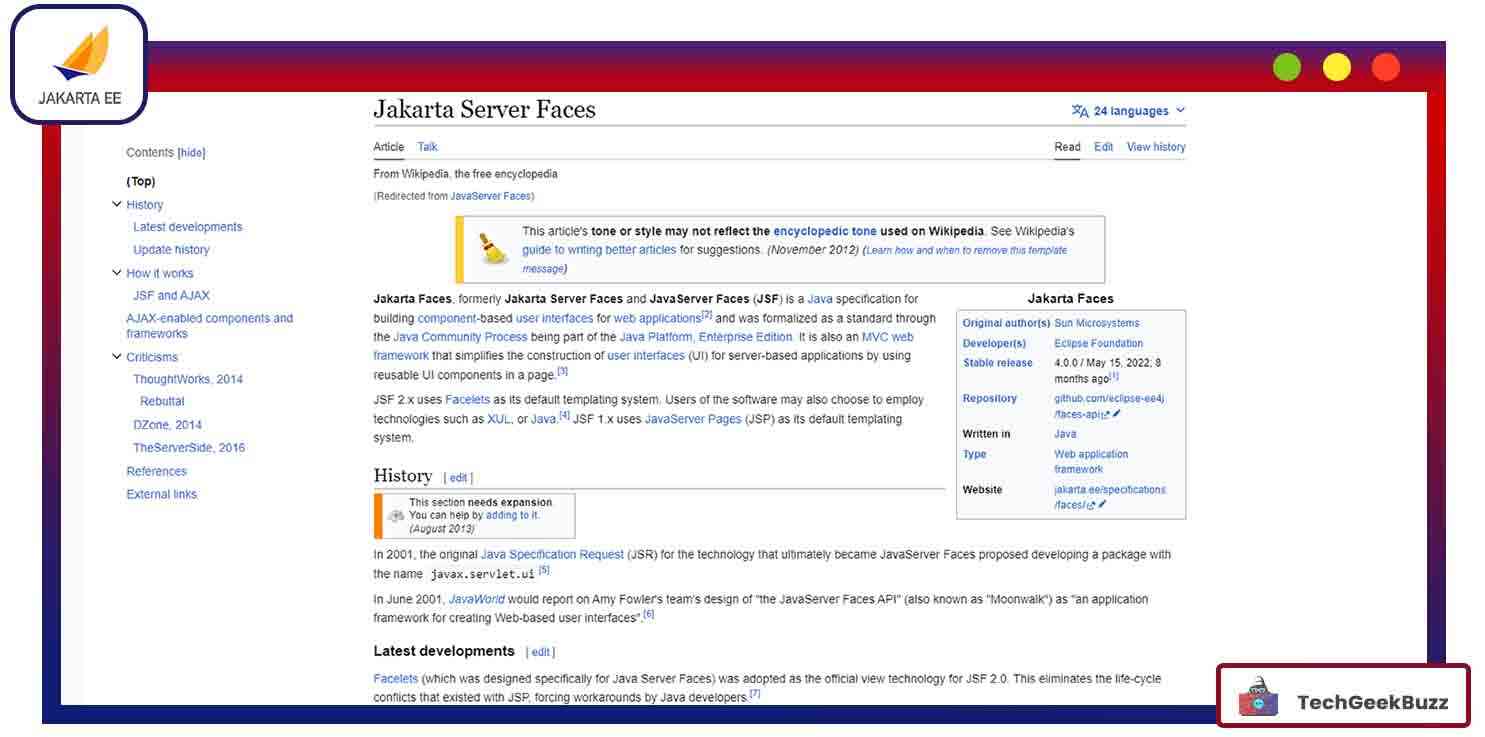
It is an open-source Java framework for creating user interfaces (UIs) for Java-based web applications. Released back in 2004 by Oracle, it is probably one of the oldest Java frameworks. The Java Community Process formalized JSF as standard and a part of Java Platform, Enterprise Edition.
JSF emphasizes using existing UI components to develop user interfaces for server-side applications. It incorporates various client-side technologies to concentrate more on the presentation layer of web applications. Furthermore, it follows the MVC ( Model-View-Controller ) architectural design pattern.
As JSF was released long ago, it now has a large and active community. Although it is a robust Java framework, its execution speed is slow. Moreover, it uses complex Java syntax, making learning challenging, especially for novices.
Features
- Facilitates industry-standard UI development
- Component-based framework
- Integrates with an expression language
- Default exception handling
- Inbuilt AJAX Support
- Offers event handlers on the server side
|
Pros |
Cons |
|
|
2. Spring Framework
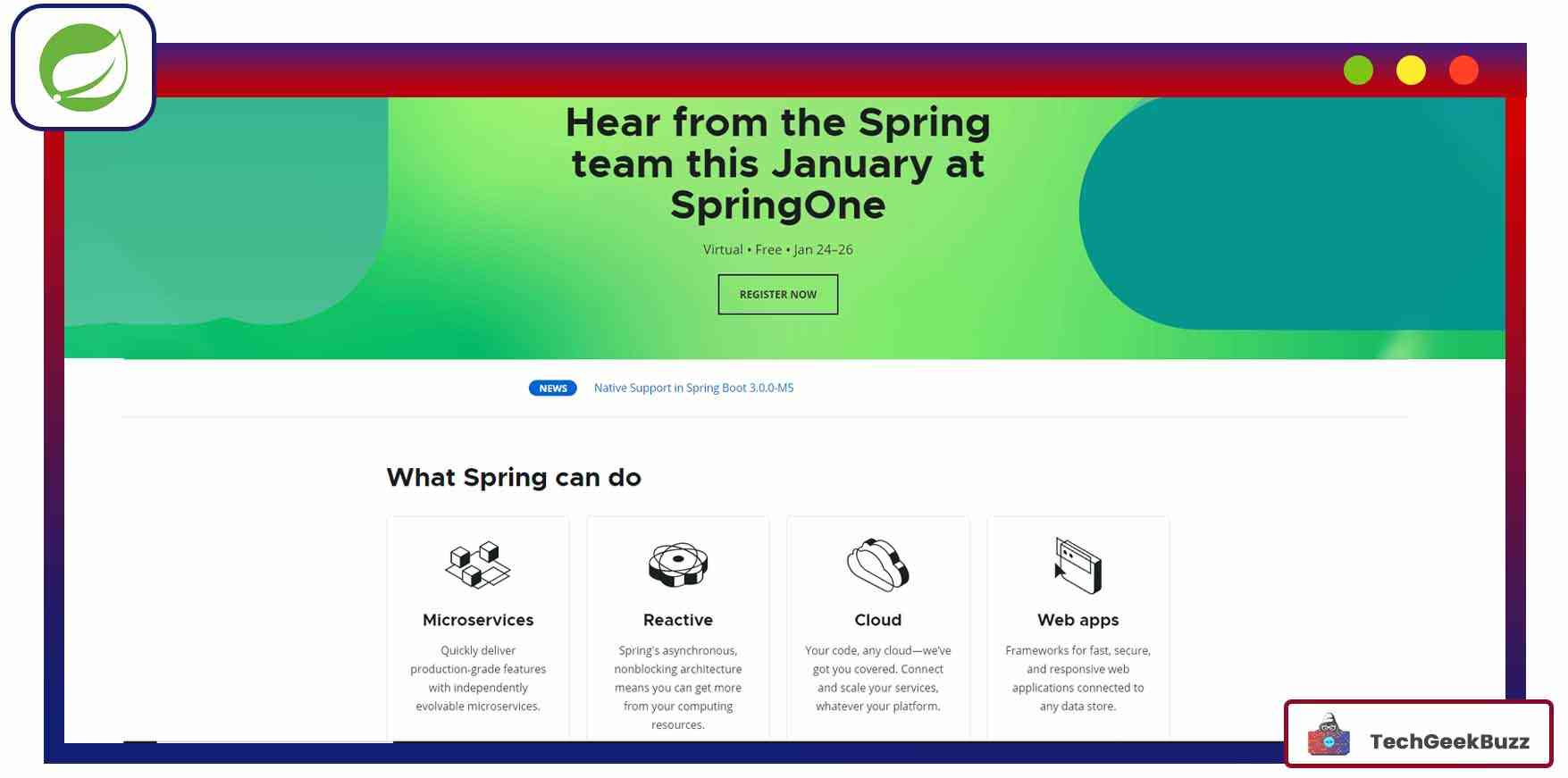
Spring is one of the most popular, powerful, and lightweight Java EE application frameworks. Developed by Pivotal Software, the first release of Spring Framework came out on 1st October 2002. Since then, this Java framework has gained popularity due to its speed, performance, and productivity.
It incorporates various other frameworks called sub-frameworks. These include Spring MVC, Spring Web Flow, and Spring ORM. As a result, it is referred to as the ‘framework of frameworks’. In addition, it powers many other projects, including Spring Boot, Spring Cloud, and Spring GraphQL.
When developing enterprise Java applications with high security, Spring comes out as a top option. Unfortunately, it has a high learning curve. Thus, for a naïve Java developer, it would not be a good choice.
Spring allows developers to create web applications and microservices, cloud applications, serverless applications, and data-driven applications. It follows the MVC architectural design pattern and is loosely coupled. Aspect-oriented programming (AOP), Plain Old Java Object (POJO), and Dependency Injection (DI) are among a few technologies that Spring uses to make the development of enterprise web applications easy and quick.
Features
- Supports relational databases
- Inversion of Control (IoC) to manage and configure Java objects
- Supports XML and annotation-base configurations
- Comes with a good set of libraries and APIs
- Supports processing data in real-time streams and batches
- Capable of creating JDBC (Java Database Connectivity) connections
|
Pros |
Cons |
|
|
3. Spark

It is a micro-framework by Apache that can work with Java and Kotlin . It is developed inspired by Sinatra, a Ruby micro-framework, and around the philosophy of Java 8 Lambda Expression. Being a micro-framework, it is faster and more efficient. Its low learning curve makes it an ideal framework for a beginner Java developer.
Spark mainly focuses on backend development . Although it does not follow the MVC architecture, you can structure your program. A terrific speed and lightweight build are its key features.
The primary aim of Spark is to provide Java and Kotlin developers with an alternative that makes it easy for them to create web applications with minimal effort and boilerplate. It has a sleek and expressive syntax that makes your code clear and concise and lets you be more productive.
However, over 50% of Spark users use it to create REST APIs and 25% to create websites.
Features
- Backward-compatible
- Does not rely on XML files and annotations
- Supports creating web applications in Java and Kotlin
|
Pros |
Cons |
|
|
4. Struts
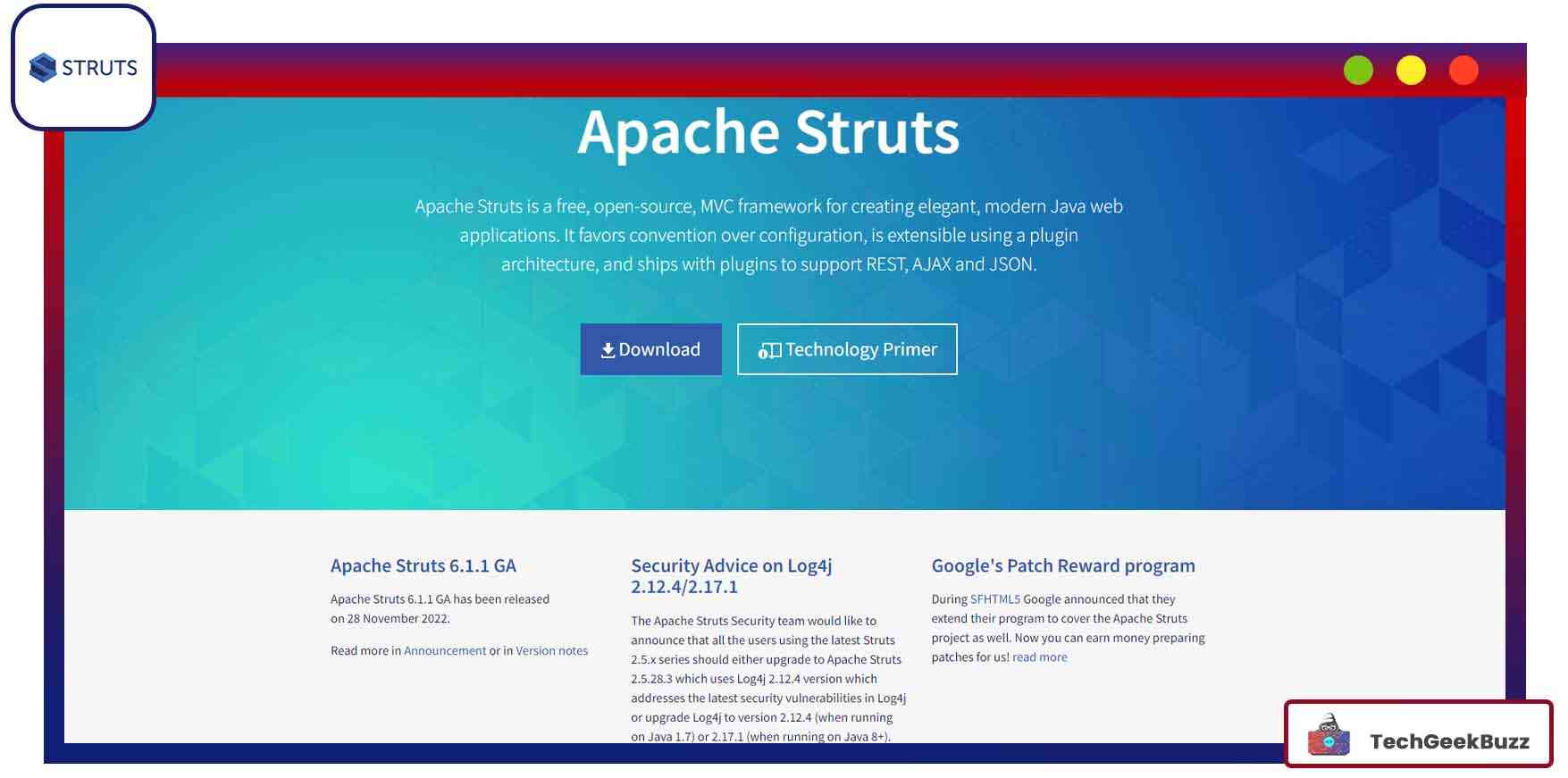
Apache Software Foundation has developed Struts, an open-source Java EE (Enterprise Edition) web framework for creating robust and modern web applications. It follows the architectural design pattern of the MVC (Model, View, Controller). Also, it primarily focuses on conventions rather than configuration. With the help of plugins, you can extend this framework and make it equipped to support REST, JSON, and AJAX.
Struts has its own syntax to follow, necessitating Java developers to first get acquainted. Nonetheless, the fast development process makes it worth learning. With its complex syntax and methodology, it's not an ideal framework for a beginner Java developer.
There are two versions of Struts: Struts 1 and Struts 2 (a combination of Struts 1 and OpenSymphony). In addition, it allows you to plug in many third-party packages and front-end interfaces.
Important Features
- Supports third-party plugins
- POJO-based actions
- Provides support to AJAX technology
- Built-in testing tools
- Three types of theme support, namely XHTML, simple and css_xhtml
|
Pros |
Cons |
|
|
5. Hibernate
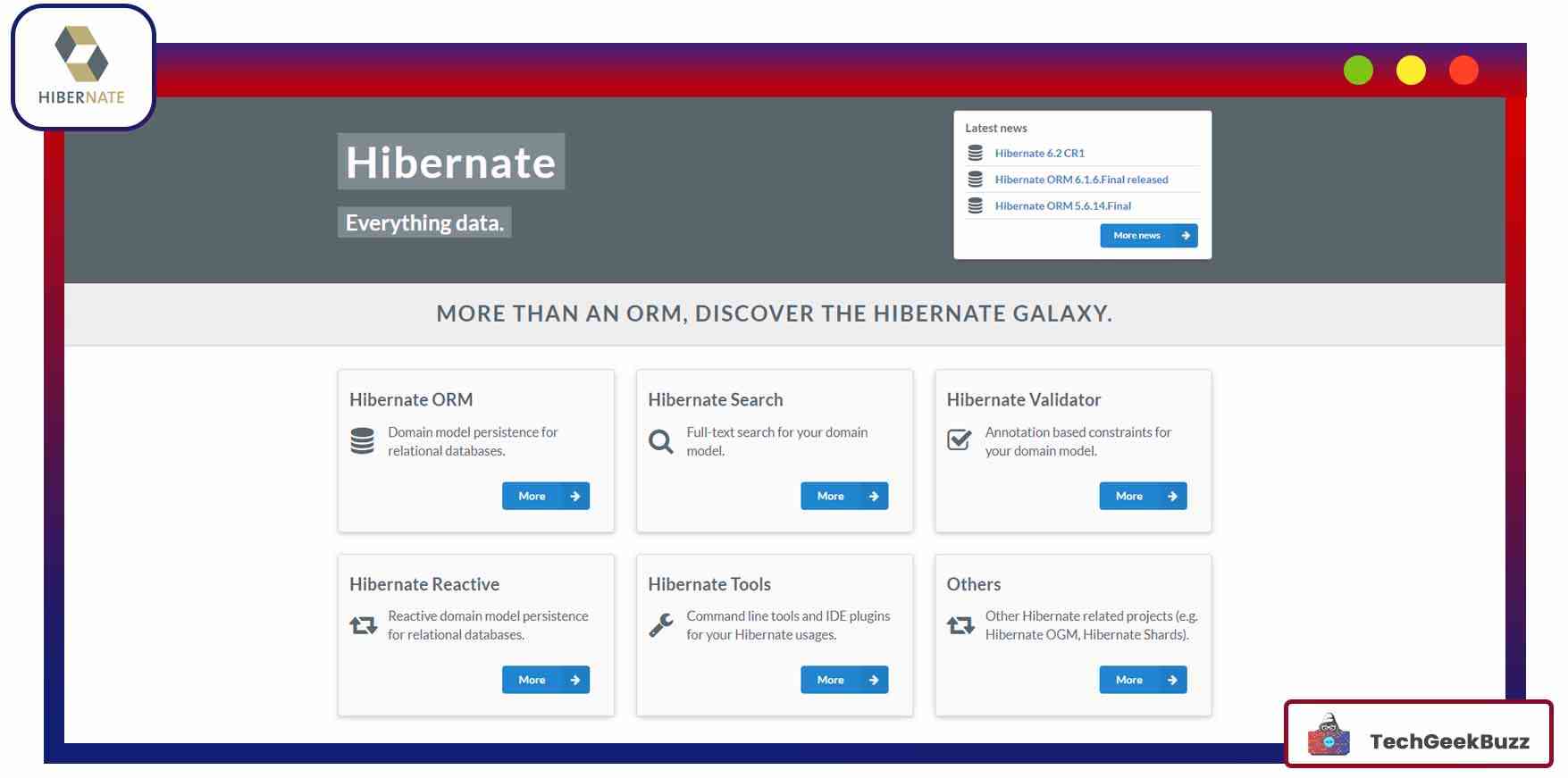
Hibernate is not actually a framework. Instead, it’s an ORM (Object-Relational Mapping) for the Java programming language. It is used to provide a framework that acts as a bridge between a relational database management system and Java. This ORM is well known for its powerful data processing feature.
The data handling process of relational databases is different from an object-oriented programming language. There are some issues when we want Java, an object-oriented programming language, to access data from the relational database , where data is stored in a tabular form. Hibernate helps to overcome such issues. The major file in Hibernate is hibernate.cfg.xml, which contains information about which Java classes to map with database configuration.
With the increasing demand for data manipulation, more and more Java developers are choosing Hibernate for their projects.
Features
- Facilitates the interaction between Java classes and relational databases
- Comes with a query language called Hibernate Query Language (HQL)
- Supports first-level and second-level caching
- Eliminates the need to write SQL queries
- Supports various databases, such as Oracle, MySQL, and Sybase
|
Pros |
Cons |
|
|
6. GWT – Google Web Toolkit
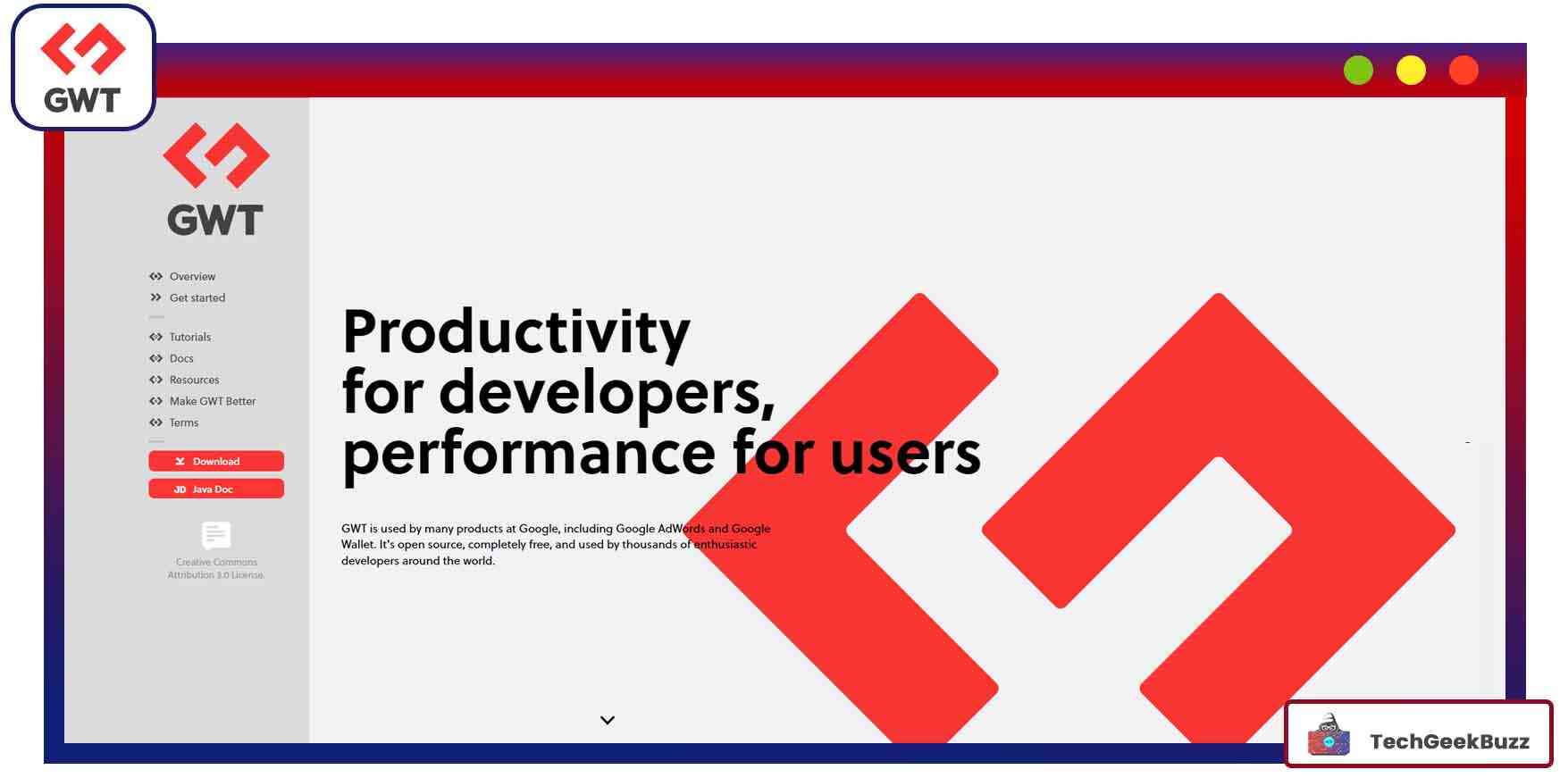
Developed by Google, GWT is an open-source tool designed to develop front-end web applications using Java. It comes with well-organized documentation that helps developers to understand it better. As you can expect from a Google product, it is a simple but powerful tool.
Though it is designed to create a client-side application, it is now able to create both client-side as well as server-side web applications. Its simplicity does not compromise the quality of the application built on it.
This toolkit has the capability to convert Java code into custom JavaScript code based on a browser. Many Google products, including Adsense, Google Wallet, etc., have been developed using GWT. In addition, the use of Google API becomes easy with GWT.
Features
- Provides two modes: development mode and web mode
- A single codebase for clients and servers
- Code navigation and refactoring
- Supports Model View Presenter (MVP) that allows shared working
- Faster testing with JUnit
- Seamless integration with various Java tools
- Reusable UI components
- Simple RPC mechanism
- Full-featured Jaba debugging
- Supports internationalization and localization
|
Pros |
Cons |
|
|
7. Play Framework
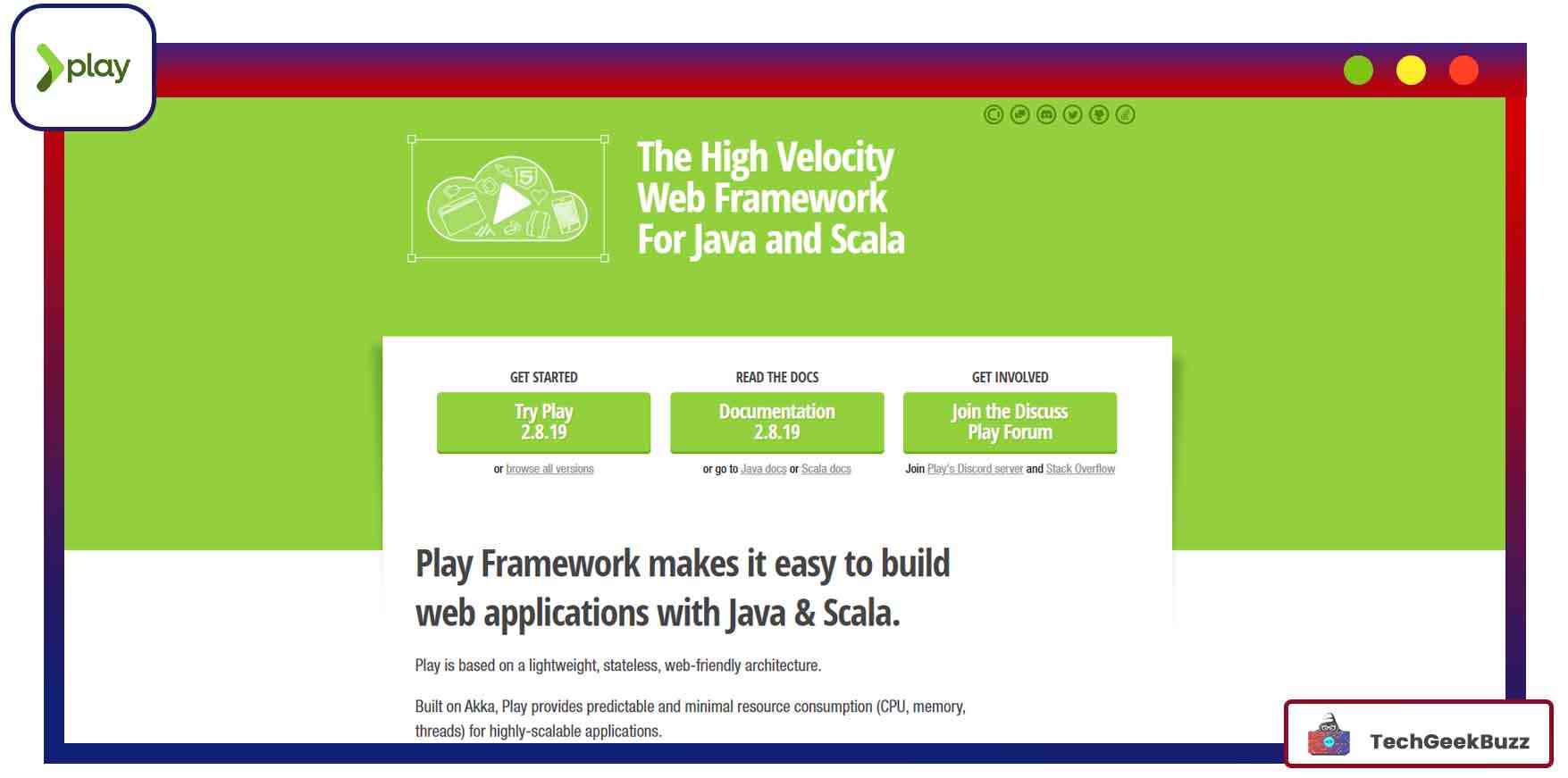
It is a powerful, open-source, lightweight Java framework developed by Lightbend in 2007. Written in Scala, Play creates web applications for all platforms. Thus, Scala developers can also use Play to create web applications.
Play is built using the Akka toolkit, making it run on the Java Virtual Machine. It also follows the MVC design patterns and has inbuilt features like code reloading and convention over configuration.
Moreover, it shares similarities with Django, Ruby on Rails, and ASP.NET architecture. Its primary focus is to reduce issues encountered in the traditional Java web development process. These issues include a lot of configurations and long development cycles.
Features
- Displays error messages in the browser
- Prefers convention over configuration
- Code reloading
- Seamless integration with various test frameworks for unit and functional testing
- Support for non-blocking I/O
- Flexible and fault-tolerant results
- Type-in safety
- Supports IDEs, such as Eclipse and IntelliJ
|
Pros |
Cons |
|
|
8. Vert.X
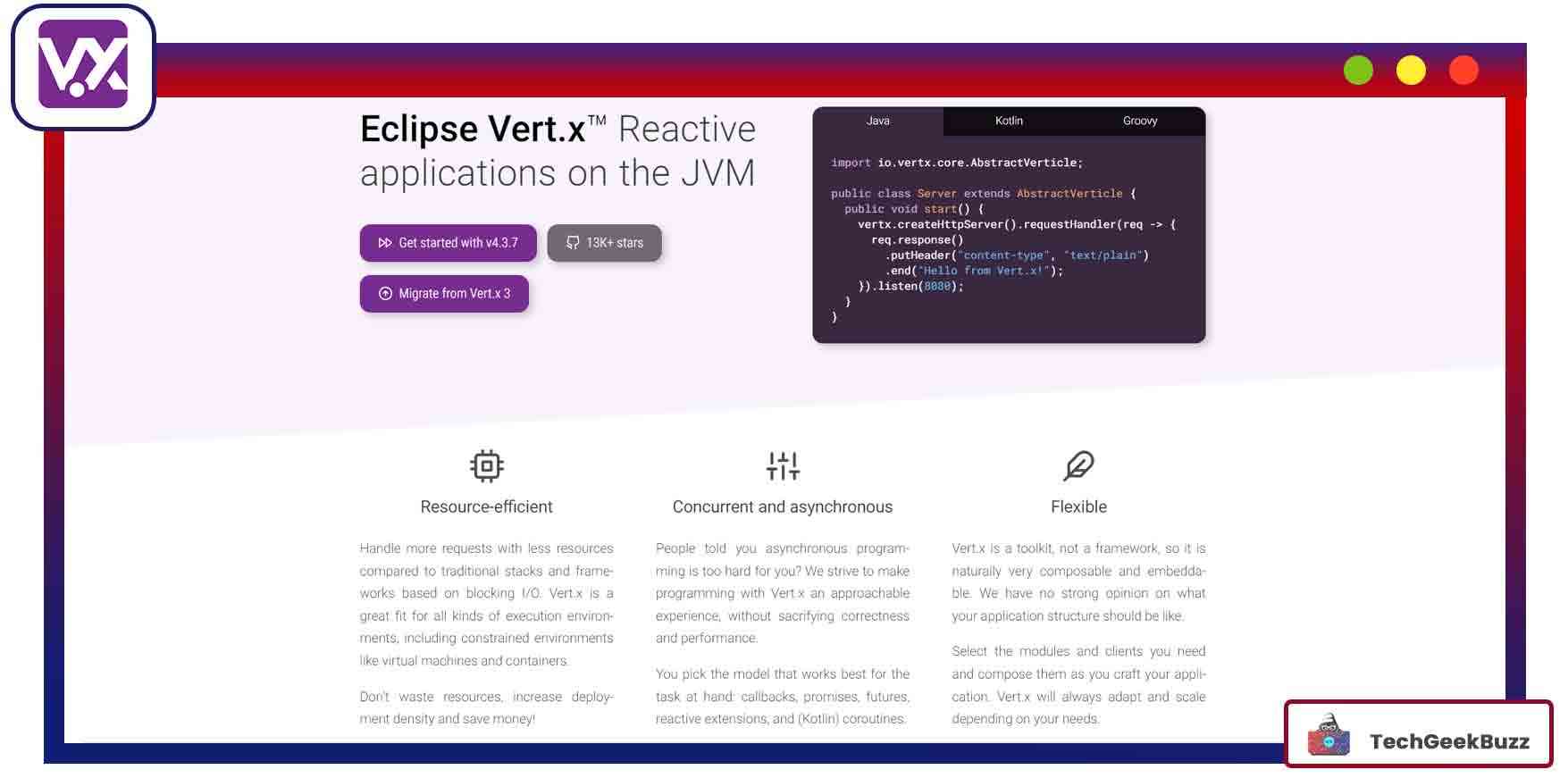
Vert.X is a polyglot event-driven application framework on the Java Virtual Machine. It supports many languages, including Java, JavaScript, Groovy, Ruby, Scala, and Kotlin. It is developed by the Eclipse Foundation, one of the leading names in Java IDEs .
‘X’ in Vert.X represents multi-language support. It is a very lightweight framework, and its file size is merely about 650 KB. Also, it follows a modular architecture, and this modular approach helps to divide the framework program into small modules.
Features
- Supports creating application components using Java, JavaScript, Kotlin, Ruby, Ceylon, and so on, as it is polyglot
- Multi-threaded programming is not a hassle since it follows a simple concurrency model.
- The simple and asynchronous programming model for building non-blocking applications
- Supports the reuse and share components through the public repository
|
Pros |
Cons |
|
|
9. Apache Wicket
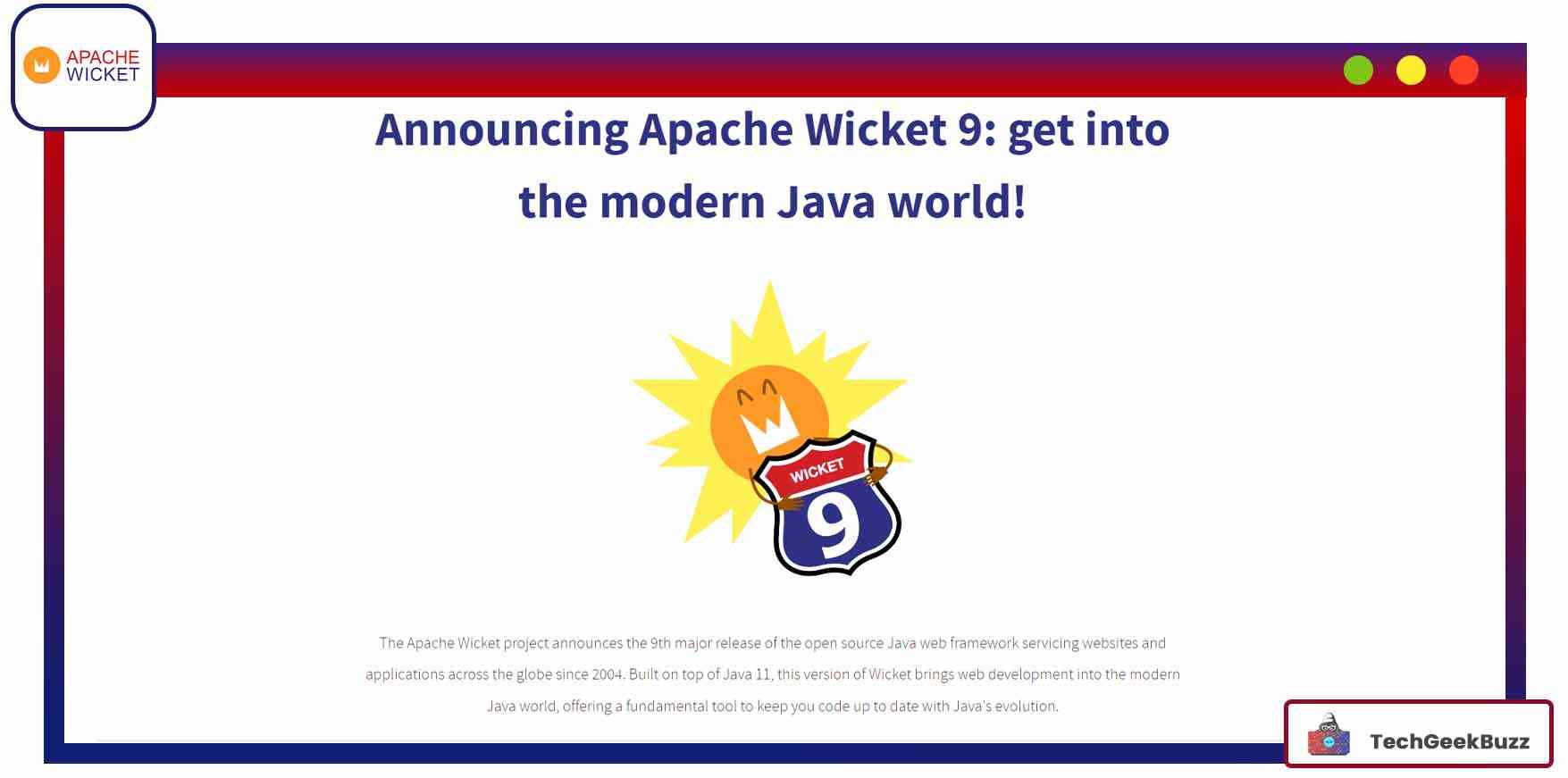
Apache Wicket is a component-based web application framework for the Java language. It is developed and maintained by Apache Software Foundation, and its 1st version was released in June 2005. It is conceptually analogous to Java Server Faces. It aims at simplifying the process of creating user interfaces.
More interestingly, Wicket requires you to possess knowledge of only Java and HTML. You must not worry about XML, JavaScript, and configuration files. It follows the MVC design pattern and uses plain XHTML for templating.
The primary feature of Wicket is the POJO model, which consists of components that are plain Java objects having object-oriented features. These components are then bundled together to form customizable packages. Developers can manipulate these packages by adding images, buttons, and other components.
Features
- Uses only pure Java and HTML to develop web applications
- Facilitates writing AJAX applications without writing a single line of JavaScript code
- Pages and components designed using Wicket support encapsulation, inheritance, and events since they are Java objects
- Multi-tab and multi-window support
- Supports JavaScript and CSS
- Various result types
- POJO-based actions
- Theme and template support
|
Pros |
Cons |
|
|
10. Vaadin
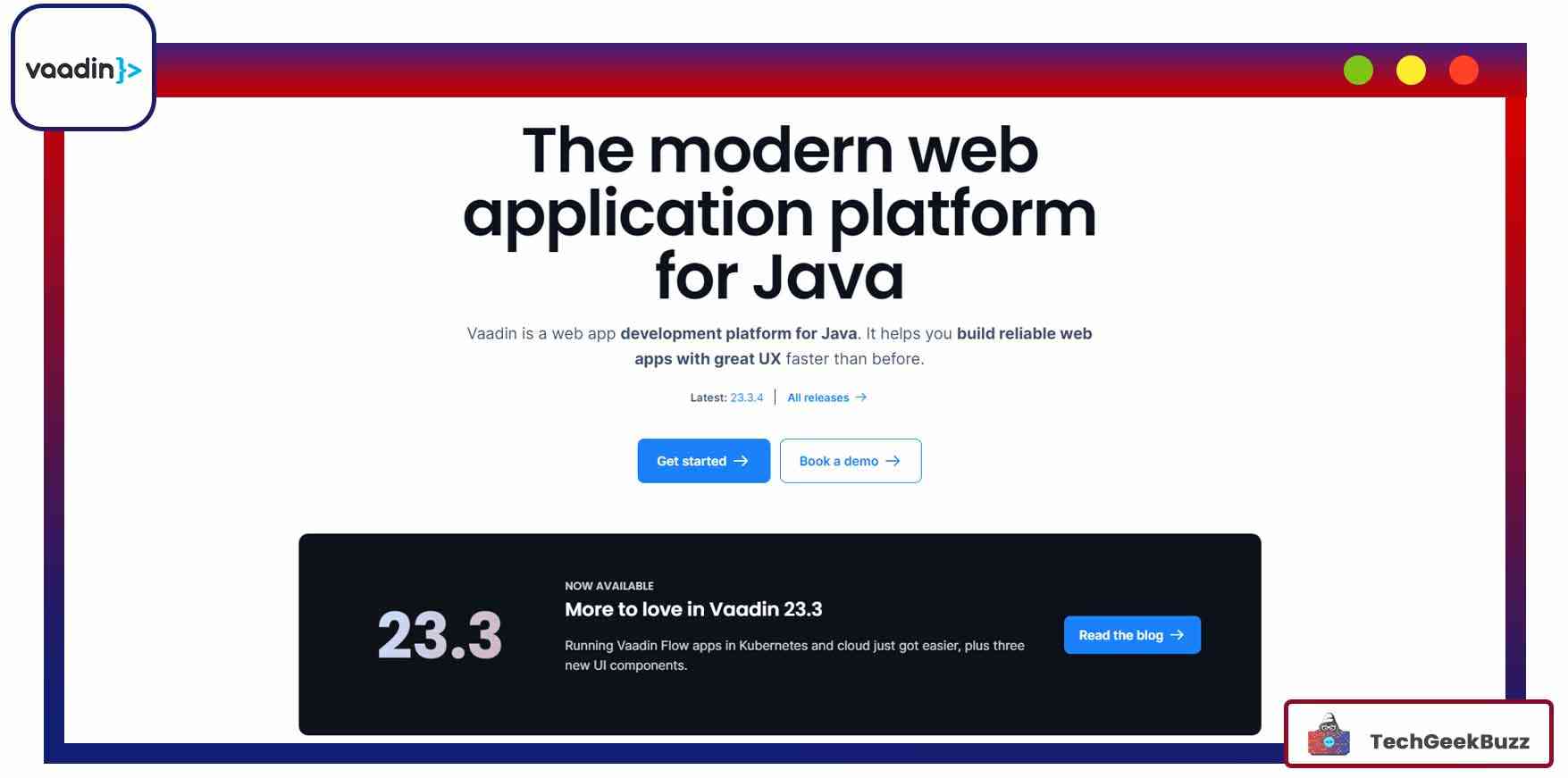
It is an open-source web development platform developed by Vaadin Ltd. and licensed by Apache Software Foundation. It is a client-server framework for developing dynamic Java web applications that provide amazing user experiences.
Vaadin Platform is Vaadin’s flagship product, enabling developers to implement HTML5 web interfaces in Java. Moreover, Vaadin comes in a lightweight version called Vaadin Flow that manages routing and client-server communication.
This framework has all the essential components and tools to create enterprise-grade secure web applications with amazing UX. You can extend the functionalities of Vaadin by integrating it with Google Web Toolkit. It does not use any markup file to render content in the browser.
As Vaadin automates client and server communication through a web socket, it is ideal for developing client-server applications.
Important Features
- Support for plugins
- Facilitates server-side programming
- A rich web interface
- Seamless integration with GWT and Ajax
- Provides various components, layouts, and listeners
- Two built-in themes: Lumo and Material
- Supports navigation without reloading the whole page
- Data binding via MVC and MVP
|
Pros |
Cons |
|
|
Conclusion
Here we have approached the end of the best Java frameworks for web development. Each framework listed on this list offers a variety of features that facilitate web application development. They come with their own set of pros and cons. They save the time required in reinventing the wheel and make you productive throughout the software development life cycle.
So, as a Java developer, it becomes essential to understand the frameworks and choose the best one per the project requirements.
If you think we are missing out on any popular Java frameworks, feel free to share them in the comments section, and we will add them to our list.
Happy Coding!
People are also reading:





Leave a Comment on this Post